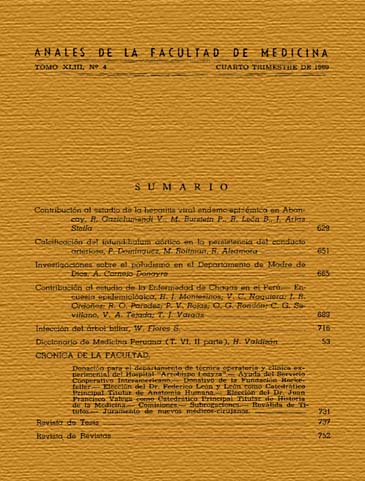Contribution to the Study of Chagas disease in Peru. Comments at Sihuas River Valley , 1956
DOI:
https://doi.org/10.15381/anales.v43i4.6346Abstract
He has visited 20 villages located along the valley Sihuas province of Arequipa, Arequipa . Was conducted epidemiological study in 180 homes , having covered nuestrta survey of 998 people. The study of housing states: overcrowded population , as the average between people and beds is 2.17. The general type of housing is quite poor ; in almost all households ( 96.11 %) pets, preferably poultry ( 92.22 %) and guinea pigs ( 83.33 %) are raised. Vector alone has been found Triantoma infestans visited 106 of housing 180 ( 58.88 % ) , of which 57 (31.6 % ) the trianomas were infected with Trypanosoma cruzi . 936 reduviid bugs have been examined , having determined a - triatomine Trypanosoma 34.09 % , being the partial data rate as follows: 25.05 % is the rate of infection from tritomas bedroom, out of a total of 427 copies; and 46.80 %, is the corresponding index in cuyeros of a total of 250 examined reduviid bugs . Clinical observations allow us suspect Chagas disease in 18 people. This suspicion was based on the presence of symptoms and signs of the disease. The study of the epidemiological profiles allowed us to suspect each dwelling houses with infected patients reduviid bugs , from bedroom. The experimental study of the material obtained has identified the Trypanosoma cruzi. Epidemiological conditions in the valley of Sihuas are favorable for the presence of Chagas disease . We try to explain the difference between infection rates found by Herrera and Ayulo and found by us , unable to state categorically that there is a reduction in these rates , but noting that such indices remain high . We believe that the application of the method Epidemiological Record Lumbreras has gained value to guide the search of scarce human and to perform appropriate epidemiological control. Finally , being endemic Chagas disease in the southern region of the country and constituting a public health problem , should be studied epidemiologically , from the point of view mainly from its impact by applying mass and reaction xenodiagnoses deviation of complement. Once diagnosed cases to proceed to a careful clinical and electrocardiographic study of them , as well as an experimental study of the flagellates to determine their virulence and pathogenicity , in order to determine the degree of gravity that is capable of producing the disease. As measures to control the disease are recommended: health education , improved housing, and away from the pens cuyeros human habitation and , in addition, frequent and periodic use of the insecticide in the cycle service This biological vector .Downloads
Published
1960-12-30
Issue
Section
Trabajos originales
License
Copyright (c) 1960 H. J. Montesinos, V. C. Naquiera, J. R. Ordóñez, R. O. Paredes, P. V. Rojas, O. G. Rondón, C. G. Sevillano, V. A. Tejada, T. J. Vargas

This work is licensed under a Creative Commons Attribution-NonCommercial-ShareAlike 4.0 International License.
Those authors who have publications with this magazine accept the following terms:
- Authors will retain their copyrights and guarantee the journal the right of first publication of their work, which will be simultaneously subject to Creative Commons Attribution License that allows third parties to share the work as long as its author and its first publication this magazine are indicated.
- Authors may adopt other non-exclusive licensing agreements for the distribution of the version of the published work (eg, deposit it in an institutional electronic file or publish it in a monographic volume) provided that the initial publication in this magazine is indicated.
- Authors are allowed and recommended to disseminate their work over the Internet (eg: in institutional telematic archives or on their website) before and during the submission process, which It can produce interesting exchanges and increase quotes from the published work. (See El efecto del acceso abierto ).
How to Cite
1.
Montesinos HJ, Naquiera VC, Ordóñez JR, Paredes RO, Rojas PV, Rondón OG, et al. Contribution to the Study of Chagas disease in Peru. Comments at Sihuas River Valley , 1956. An Fac med [Internet]. 1960 Dec. 30 [cited 2024 Aug. 16];43(4):689-715. Available from: https://revistasinvestigacion.unmsm.edu.pe/index.php/anales/article/view/6346















